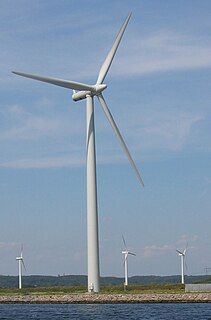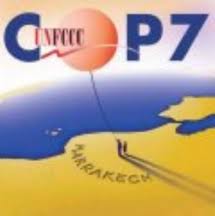"Supplementarity", also referred to as "the supplementary principle", is one of the main principles of the Kyoto Protocol. The concept is that internal abatement of emissions should take precedence before external participation in flexible mechanisms. These mechanisms include emissions trading, Clean Development Mechanism (CDM), and Joint Implementation (JI).
Emissions trading basically refers to the trading of emissions allowances (carbon credits) between one regulated entity and a less pollutive entity. This trading of permits results in a marginal economic disincentive to the buyer and a marginal economic incentive the abater.
CDM and JI are flexible mechanisms based on the concept of a carbon project. These projects reduce GHG voluntarily (outside the capped sectors) and therefore can be imported into the capped sector to aid in compliance.
The supplementarity principle is found in three articles of the Kyoto Protocol: article 6 and 17 with regards to trading, and article 12 with regards to the clean development mechanism.
Article 6.1 states that "The acquisition of emission reduction units shall be supplemental to domestic actions for the purposes of meeting commitments under Article 3". Article 17 states that "[…]Any such trading shall be supplemental to domestic actions for the purpose of meeting quantified emission limitation and reduction commitments under that article". Article 12.3.b states that "Parties included in Annex I may use the certified emission reductions accruing from such project activities to contribute to compliance with part of their quantified emission limitation and reduction commitments under Article 3[…]".
The actual meaning of the principle has been heavily argued since the signing of Kyoto Protocol in 1997. The COP/MOP is the body that represents the signers/ratifiers of the protocol and they have not been able to agree on a specific definition of the limit on use of flexible mechanisms. The original text has been interpreted to mean that anywhere from 3-50% of emissions could be offset by trading mechanisms. However, the only determination that has been thustly made is that the actual value of supplementarity should be decided at the country level.
In the United States RGGI (Regional Greenhouse Gas Initiative) has set a precedent in that it will initially allow only up to 3.3% compliance occur by means of offset projects (carbon projects). This value can increase to 5% and ultimately 10% if certain price thresholds are exceeded in the region.

The Kyoto Protocol was an international treaty which extended the 1992 United Nations Framework Convention on Climate Change (UNFCCC) that commits state parties to reduce greenhouse gas emissions, based on the scientific consensus that (part one) global warming is occurring and (part two) that human-made CO2 emissions are driving it. The Kyoto Protocol was adopted in Kyoto, Japan, on 11 December 1997 and entered into force on 16 February 2005. There were 192 parties (Canada withdrew from the protocol, effective December 2012) to the Protocol in 2020.
A carbon credit is a generic term for any tradable certificate or permit representing the right to emit one tonne of carbon dioxide or the equivalent amount of a different greenhouse gas (tCO2e).
The Clean Development Mechanism (CDM) is a United Nations-run carbon offset scheme allowing countries to fund greenhouse gas emissions-reducing projects in other countries and claim the saved emissions as part of their own efforts to meet international emissions targets. It is one of the three Flexible Mechanisms defined in the Kyoto Protocol. The CDM, defined in Article 12 of the Protocol, was intended to meet two objectives: (1) to assist non-Annex I countries achieve sustainable development and reduce their carbon footprints; and (2) to assist Annex I countries in achieving compliance with their emissions reduction commitments.

A carbon offset is a reduction or removal of emissions of carbon dioxide or other greenhouse gases made in order to compensate for emissions made elsewhere. Offsets are measured in tonnes of carbon dioxide-equivalent (CO2e). One ton of carbon offset represents the reduction or removal of one ton of carbon dioxide or its equivalent in other greenhouse gases. Both the Oxford Principles for Net Zero Aligned Offsetting and the Science Based Targets initiative's Net-Zero Criteria argue for the importance of moving beyond offsets based on reduced or avoided emissions to offsets based on carbon that has been sequestered from the atmosphere, such as CO2 Removal Certificates (CORCs).

The European Union Emissions Trading System (EU ETS), was the first large greenhouse gas emissions trading scheme in the world. It was launched in 2005 to fight global warming and is a major pillar of EU energy policy. As of 2013, the EU ETS covers more than 11,000 factories, power stations, and other installations with a net heat excess of 20 MW in 31 countries—all 27 EU member states plus Iceland, Norway, Liechtenstein and United Kingdom. In 2008, the installations regulated by the EU ETS were collectively responsible for close to half of the EU's anthropogenic emissions of CO2 and 40% of its total greenhouse gas emissions. The EU had set a target for 2020 to cut greenhouse gas emissions by 20% compared with 1990, to reduce energy consumption by 20% compared to the 2007 baseline scenario, and to achieve a 20% share of gross final energy consumption from renewable energy sources - all of which was achieved. A 2020 study estimated that the EU ETS had reduced CO2 emissions by more than 1 billion tons between 2008 and 2016 or 3.8% of total EU-wide emissions.
Flexible mechanisms, also sometimes known as Flexibility Mechanisms or Kyoto Mechanisms, refers to emissions trading, the Clean Development Mechanism and Joint Implementation. These are mechanisms defined under the Kyoto Protocol intended to lower the overall costs of achieving its emissions targets. These mechanisms enable Parties to achieve emission reductions or to remove carbon from the atmosphere cost-effectively in other countries. While the cost of limiting emissions varies considerably from region to region, the benefit for the atmosphere is in principle the same, wherever the action is taken.
Joint Implementation (JI) is one of three flexibility mechanisms set out in the Kyoto Protocol to help countries with binding greenhouse gas emissions targets meet their treaty obligations. Under Article 6, any Annex I country can invest in a project to reduce greenhouse gas emissions in any other Annex I country as an alternative to reducing emissions domestically. In this way countries can lower the costs of complying with their Kyoto targets by investing in projects where reducing emissions may be cheaper and applying the resulting Emission Reduction Units (ERUs) towards their commitment goal.
Carbon finance is a branch of environmental finance that covers financial tools such as carbon emission trading to reduce the impact of greenhouse gases (GHG) on the environment by giving carbon emissions a price.
Greenhouse gas inventories are emission inventories of greenhouse gas emissions that are developed for a variety of reasons. Scientists use inventories of natural and anthropogenic (human-caused) emissions as tools when developing atmospheric models. Policy makers use inventories to develop strategies and policies for emissions reductions and to track the progress of those policies. Regulatory agencies and corporations also rely on inventories to establish compliance records with allowable emission rates. Businesses, the public, and other interest groups use inventories to better understand the sources and trends in emissions.
A mobile emission reduction credit (MERC) is an emission reduction credit generated within the transportation sector. The term “mobile sources” refers to motor vehicles, engines, and equipment that move, or can be moved, from place to place. Mobile sources include vehicles that operate on roads and highways, as well as nonroad vehicles, engines, and equipment. Examples of mobile sources are passenger cars, light trucks, large trucks, buses, motorcycles, earth-moving equipment, nonroad recreational vehicles, farm and construction equipment, cranes, lawn and garden power tools, marine engines, ships, railroad locomotives, and airplanes. In California, mobile sources account for about 60 percent of all ozone forming emissions and for over 90 percent of all carbon monoxide (CO) emissions from all sources.

Certified Emission Reductions (CERs) are a type of emissions unit issued by the Clean Development Mechanism (CDM) Executive Board for emission reductions achieved by CDM projects and verified by a DOE under the rules of the Kyoto Protocol.
The Weighted average cost of carbon is used in finance to measure a firm's specific cost of carbon. It expresses how much an organization is expending to either reduce carbon emissions internally or offsetting externally. As such, the weighted average cost of carbon is the cost a company incurs to balance its carbon liability.
EcoSecurities is a company specialised in carbon markets and greenhouse gas (GHG) mitigation projects worldwide. EcoSecurities specialises in sourcing, developing and financing projects on renewable energy, energy efficiency, forestry and waste management with a positive environmental impact.
An assigned amount unit is a tradable "Kyoto unit" or "carbon credit" representing an allowance to emit greenhouse gases comprising "one metric tonne of carbon dioxide equivalent, calculated using global warming potentials". Assigned amount units are issued up to the level of initial "assigned amount" of an Annex 1 Party to the Kyoto Protocol.

The economics of climate change mitigation is the part of the economics of climate change related to climate change mitigation, that is actions that are designed to limit the amount of long-term climate change. Mitigation may be achieved through the reduction of greenhouse gas (GHG) emissions and the enhancement of sinks that absorb GHGs, for example forests.
This article is about the Kyoto Protocol and government action in relation to that treaty.
This article is about certain views on the Kyoto Protocol to the United Nations Framework Convention on Climate Change.
Pedro Moura Costa is an entrepreneur involved in environmental finance with a focus on the international efforts for greenhouse gas (GHG) emission reductions. Of particular relevance, he was the founder and President of EcoSecurities Group Plc., one of the leading project developers for the international carbon markets, and has written widely about the policy and science of climate change mitigation, including contributions to the Intergovernmental Panel on Climate Change (IPCC) reports.

The 2001 United Nations Climate Change Conference took place from October 29 to November 10, 2001 in Marrakech, Morocco. The conference included the 7th Conference of the Parties (COP7) to the United Nations Framework Convention on Climate Change (UNFCCC). The negotiators wrapped up the work on the Buenos Aires Plan of Action, finalizing most of the operational details and setting the stage for nations to ratify the Kyoto Protocol. The completed package of decisions is known as the Marrakech Accords. The United States delegation maintained its observer role, declining to participate actively in the negotiations. Other parties continued to express hope that the United States would re-engage in the process at some point and worked to achieve ratification of the Kyoto Protocol by the requisite number of countries to bring it into force. The date of the World Summit on Sustainable Development was put forward as a target to bring the Kyoto Protocol into force. The World Summit on Sustainable Development (WSSD) was to be held in Johannesburg, South Africa.

The United Nations Climate Change Conferences are yearly conferences held in the framework of the United Nations Framework Convention on Climate Change (UNFCCC). They serve as the formal meeting of the UNFCCC parties to assess progress in dealing with climate change, and beginning in the mid-1990s, to negotiate the Kyoto Protocol to establish legally binding obligations for developed countries to reduce their greenhouse gas emissions. Starting in 2005 the conferences have also served as the "Conference of the Parties Serving as the Meeting of Parties to the Kyoto Protocol" (CMP); also parties to the convention that are not parties to the protocol can participate in protocol-related meetings as observers. From 2011 to 2015 the meetings were used to negotiate the Paris Agreement as part of the Durban platform, which created a general path towards climate action. Any final text of a COP must be agreed by consensus.